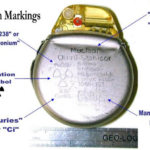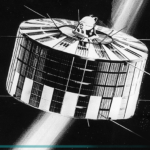Long-life pacemakers powered by plutonium-based thermal decay were implanted beginning in the 1970s, but better battery technology, safety concerns, and regulatory issues made them obsolete within a few decades.
The long-term implications
Q: Assuming the RTG version works well, what happens when the patient passes away?
A: That’s when the RTG saga gets even more complicated and costly.
Due to their extremely long life, nuclear pacemakers tended to outlive their users, and the regulatory “feeling” was that the deceased couldn’t be buried with them due to radiation exposure risks. (Actually, burying the unit is probably among the safest things you can do – and note that even consumer smoke detectors have a tiny amount of man-made radioactive Americium-241 in their sensing core.)
When one of these individuals dies, the pacemaker is supposed to be removed and examined at a medical institution. If any of the markings confirm that the device is a pacemaker that contains radioactive material, that institution is supposed to contact the Los Alamos National Laboratory OSRP (Off-Site Recovery Program) for shipping and disposal instructions, where the plutonium will be recovered.
Q: Are there other unintended consequences?|
A: Absolutely. The Wall Street Journal did a lengthy article on the subject (Reference 3) discussing a patient who had a plutonium-238 pacemaker implanted in 1975. When she passed away 34 years later, it was no longer functioning due to electrical, not plutonium-source, issues. The procedure had been done at the Hahnemann University Hospital in Philadelphia, which went bankrupt and closed in 2010, soon after her passing.
A problem was discovered, however, when officials reviewed the thousands of documents from the hospital as it was closing. The doctor originally responsible for returning the device to the manufacturer (after the patient’s death) had left the hospital, and the manufacturer had gone out of business, so none of the parties involved was able to take responsibility for tracking the device.
According to the article, the Hahnemann hospital spent more than $15,000 over a six-month period to continue to meet the terms of the pacemaker’s nuclear-regulatory license from the Nuclear Regulatory Commission. Eventually, they received formal permission from the NRC to transfer the “rights” to this particular pacemaker and its plutonium to a third-party company that specialized in handling this sort of highly regulated material.
Conclusion
The RTG-powered pacemaker was certainly a viable solution to the problem of long-term powering of these lifesaving implanted devices, especially when compared to the alternatives, but it also brought many accompanying and challenging issues of various types. Their practicality ended when enhancements in pacemaker technology, coupled with significant improvements in batteries due to lithium-based chemistries, radically changed the related tradeoffs and attractiveness of the available solution. Nuclear-based RTG pacemakers had their brief “glory”, but the benefits were outweighed by their issues, while the alternative solutions have proven to be much more practical, less costly, smaller, and less burdened by technical and regulatory issues.
EE World related content
Need a really long-life battery or heat? Try a radioisotope thermal source – problem solved! – Part 1
Need a really long-life battery or heat? Try a radioisotope thermal source – problem solved! – Part 2
Need a really long-life battery or heat? Try a radioisotope thermal source – problem solved! – Part 3
Need a really long-life battery or heat? Try a radioisotope thermal source – problem solved! – Part 4
Need a really long-life battery or heat? Try a radioisotope thermal source – problem solved! – Part 5
Engineering the atomic submarine, Part 1: One man’s audacity, determination, dedication revolutionized naval reality
Engineering the atomic submarine, Part 2: One man’s audacity, determination, dedication revolutionized naval reality
Smoke detectors and alarms, Part 1
Smoke detectors and alarms, Part 2
Smoke detectors and alarms, Part 3
Smoke detectors and alarms, Part 4
References
National Institutes of Health, “A brief history of cardiac pacing”
IEEE Spectrum, “Who Really Invented the Rechargeable Lithium-Ion Battery?”
The Wall Street Journal, “How Do You Handle a Plutonium-Powered Pacemaker?” (behind a paywall)
Los Alamos National Laboratory, “Nuclear-Powered Cardiac Pacemakers”
Oak Ridge Museum of Radiation and Radioactivity, “Plutonium Powered Pacemaker (1974)”
Stanford University, “The History of Nuclear Powered Pacemakers”
Medical Design and Outsourcing, “MedTech Memoirs: The Plutonium-Powered Pacemaker”
Nuclear Newswire, “The case of the Pu-powered pacemaker”
Washington Heart Rhythm Associates, LLC, “Permanent Pacemaker: What is a pacemaker?”







Leave a Reply